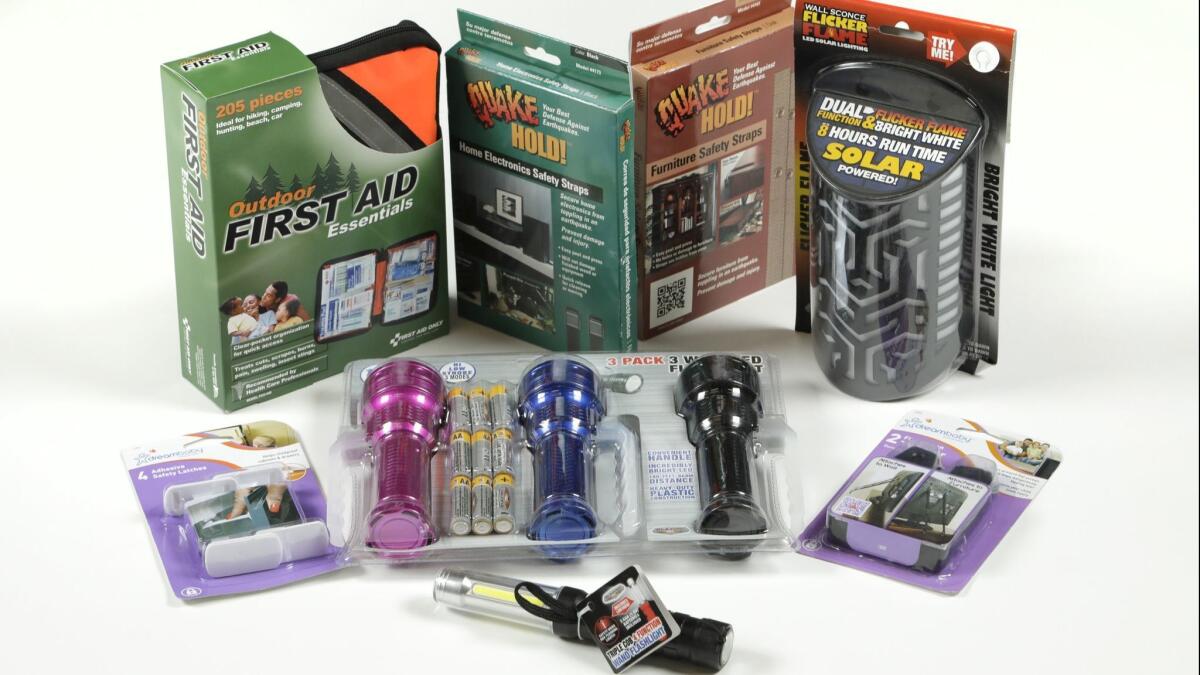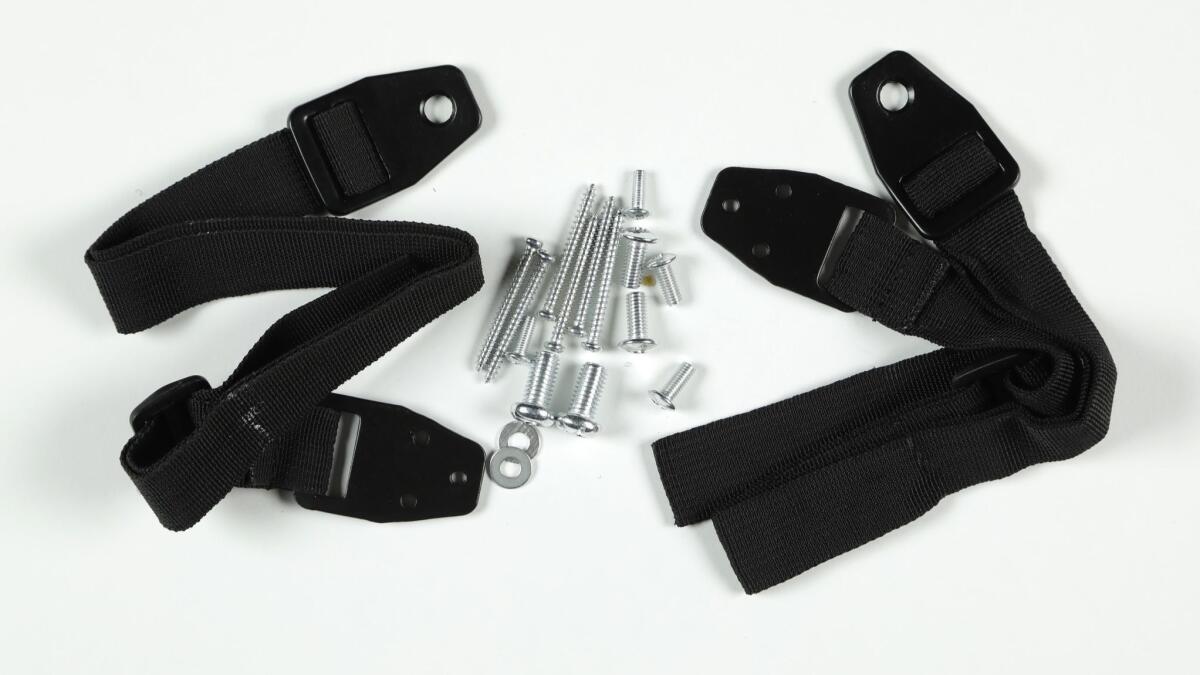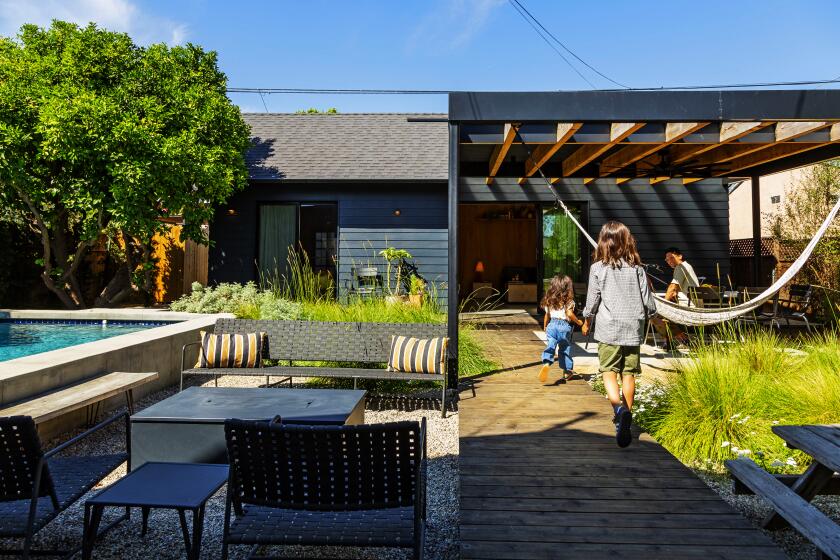The 9 earthquake hazards lurking in your home

- Share via
You’ve seen the images of sloshing pools, and scattered and smashed bottles in the stores of Ridgecrest, epicenter of the largest earthquake to hit Southern California in nearly 20 years. Many of us in L.A. were spared, subject to only a queasy rolling. But look around your home and imagine that violent movement under your place, throwing your stuff everywhere.
Good. Now you’re ready to start earthquake-proofing your home.
A few minutes of weekend prep can save hours of cleanup after a major earthquake, not to mention preserve the framed wedding pictures lovingly hung over your headboard, or the 65-inch TV you just bought for March Madness. And most of it can be accomplished with a quick trip to the hardware store or home center.
Earthquake preparedness tips — for your pets: How to keep them safe »
All the emergency agents and experts, including the California Earthquake Authority, the Los Angeles County Office of Emergency Management, FEMA and the Earthquake Country Alliance, say step No. 1 in earthquake safety is shoring up your first line of defense, your home.
“I call it structural triage — you go for the most important things first,” said Janiele Maffei, chief mitigation officer of the CEA. “You’re kind of looking around. You don’t have to do it [all] tomorrow; the key is to always be moving forward.”
Packing an emergency kit? Think about using your camping gear »
Here are a few ways to get started. If you knock out just one a week for the rest of the year, you’ll be better prepared than most. And once the easy projects are done, check off other crucial to-dos. “You can start to chip away at the bigger, more expensive things,” Maffei said.
1. TVs and bookshelves: These are a couple of items most likely to tip over (and create a cleanup headache, even if they don’t land on your head). Buy furniture straps to unobtrusively secure these to wall studs. Also strap down file cabinets and other top-heavy furniture that can fall and potentially block exits. If you hope to keep books on the shelves, installing a lip along the front edge might keep them from flying off and hurting someone. Another option: Escondido-based QuakeHold makes elastic cord barriers that still allow access.

2. Kitchen cabinets: All your cups and glasses will become tumblers, when a quake hurls them past the cabinet doors and onto the floor. Child-safety locks can keep the doors closed but can be a hassle to open normally. Several companies offer more convenient locks that you simply push to open and release a latch. San Diego-based Safe-T-Proof sells cabinet locks that fall into place when shaking starts. The cabinet contents may still shatter during the Big One, but at least breakage will be contained and not underfoot.
3. Items on shelves: Knickknacks, Grandmother’s china or crystal vases can turn into financial and emotional losses, and dangerous projectiles, according to the Earthquake Alliance. That agency, a public-private partnership that organizes the annual Great California ShakeOut earthquake drill, recommends using Velcro, adhesive gel or QuakeHold Museum Wax to affix those items directly to shelves.
Packing an emergency kit? Think about using your camping gear »
4. Pictures, mirrors and other wall hangings: These can all become projectiles, or shatter and rain glass on your head in an earthquake. Instead of nails or regular picture hooks, use screw hooks or earthquake-specific hangers installed directly into wall studs, not just the plaster, the Earthquake Alliance suggests. A little putty on the back corners will help keep the frames from banging against the walls and breaking. And the alliance advises hanging only soft objects, such as tapestries, above beds.
5. Wine, liquor, chemicals — and other items that can shatter and spill: Keep these low to the ground in a secured cabinet so they won’t fly out and it won’t tip over. Wine, upright in wooden boxes, might survive. But not if they’re stacked very high, or if bottles are resting sideways atop one another. Wine Spectator magazine says tipping up the necks of bottles in a rack even five degrees will help keep them from shaking out of place.
6. The water heater: Once the ground under it starts moving, a tall, heavy water heater can topple, breaking the water and natural gas lines running to it. Also, that tank holds 30 to 50 gallons of fresh water — vital, if a quake at the San Andreas fault severs the Los Angeles Aqueduct. Be sure to use heavy-duty straps designed for the job to secure the top and bottom; don’t use brittle, bendy “plumber’s tape.” And if your water heater, stove and other appliances aren’t hooked to the gas lines using flexible connectors — they look like bendy straws — consider calling a plumber to swap those in.
7. The unexpected: The Earthquake Country Alliance checklist also mentions hazards that might not occur to people, such as hanging plants too close to windows, where they could swing and break the glass.
8. Unbraced home: Is your home bolted to its foundation? If not, the job averages $5,000 in Southern California yet can avert damage costs into the six figures, or even a home’s outright destruction if it slides off its footings. “If you have a crawl space, you really need to get under there and take a look. If it’s a pre-1940s house, you absolutely have to take a look,” said Maffei, who is also executive director of the California Residential Mitigation Program, created jointly by the Earthquake Authority and the governor’s office, to help people brace their homes.
The CRMP website — californiaresidentialmitigationprogram.com — gives tips on earthquake retrofitting and offers a search function for FEMA-certified contractors. And its Earthquake Brace + Bolt program offers grants up to $3,000 to offset the cost of securing homes, although those are all claimed for this year.
9. A toppling fireplace? If you have a brick or masonry chimney, those are “the most vulnerable components of conventionally constructed wood-framed homes,” according to the Structural Engineers Association of California. It estimated the Northridge earthquake destroyed or damaged beyond repair about 60,000 chimneys. Also, falling bricks can pummel bystanders — indoors and out — as well as property.
Engineers debate whether current building codes are enough to keep chimneys safe, and whether reinforcing old ones simply creates a single unit that will fall over. They argue the safest option is a factory-made metal chimney, enclosed in veneer to simulate brick, for the traditional look. Maffei’s recommendation? Evaluate the potential hazard: “If it pulled away from the wall and fell down, what could it hit?”
More to Read
Sign up for The Wild
We’ll help you find the best places to hike, bike and run, as well as the perfect silent spots for meditation and yoga.
You may occasionally receive promotional content from the Los Angeles Times.










